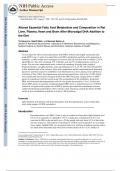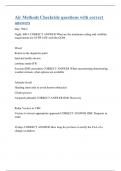Altered Essential Fatty Acid Metabolism and Composition in Rat
Liver, Plasma, Heart and Brain After Microalgal DHA Addition to
the Diet
Yu Hong Lin , Samit Shah , and Norman Salem Jr.
Section of Nutritional Neuroscience, Laboratory of Membrane Biochemistry and Biophysics,
National Institute on Alcohol Abuse and Alcoholism, National Institutes of Health
Abstract
To investigate the effect of docosahexaenoic acid (DHA) without other highly unsaturated fatty
acids (HUFA) on n-3 and n-6 essential fatty acid (EFA) metabolism and fatty acid composition in
mammals, a stable isotope tracer technique was used in adult rats fed diets with or without 1.3% of
algal DHA in a base diet containing 15% of linoleic acid and 3% of alpha-linolenic acid over 8
weeks. The rats were administered orally a mixed oil containing 48 mg/kg body weight of
deuterated linoleic and alpha-linolenic acids and euthanized at 4, 8, 24, 96, 168, 240, 360 and 600
h after administration of the isotopes. Fatty acid compositions and the concentrations of deuterated
precursors and their respective metabolites were determined in rat liver, plasma, heart and brain as
a function of time. DHA, docosapentaenoic acid and eicosapentaenoic acid in the n-3 EFA family
were significantly increased in all organs tested in the DHA-fed group, ranging from 5 to 200%
greater in comparison with the control group. The accumulation of the metabolites, deuterated-
DHA and deuterated-docosapentaenoic acid n-6 were greatly decreased by 1.5 to 2.5 fold in the
dietary DHA group. In summary, feeding preformed DHA led to a marked increase in n-3 HUFA
content of rat organs at the expense of n-6 HUFA and also prevented the accumulation of newly
synthesized deuterated end products. This is the first study which has isolated the effects of DHA
on the de novo metabolism on both the n-6 and n-3 EFA pathways.
Keywords
alpha-linolenic acid; linoleic acid; docosahexaenoic acid; docosapentaenoic acid; essential fatty
acid; stable isotope; GC/MS; metabolism
Introduction
Docosahexaenoic acid (DHA, 22:6n-3) may be synthesized from plant alpha-linolenic acid
(18:3n-3) in mammals (1), although 4 ∼5% of a single dose of deuterated 18:3n-3 was
converted to DHA in the rat body over a 25 day period with only about 0.1% of that in the
nervous system (2). The majority of the dietary C18 EFAs are β-oxidized (2-4). In isotopic
tracer studies, labeled DHA was incorporated into liver and brain in baboon neonates and in
rats much more efficiently than when derived from labeled-18:3n-3 (5,6). Studies of
Corresponding author: Norman Salem, Jr., Ph.D., Martek Biosciences Corp., 6480 Dobbin Road, Columbia, MD 21045 USA, Fax:
301-594-0035, nsalem@martek.com.
Publisher's Disclaimer: This is a PDF file of an unedited manuscript that has been accepted for publication. As a service to our
customers we are providing this early version of the manuscript. The manuscript will undergo copyediting, typesetting, and review of
the resulting proof before it is published in its final citable form. Please note that during the production process errors may be
discovered which could affect the content, and all legal disclaimers that apply to the journal pertain.
NIH Public Access
Author Manuscript
J Nutr Biochem . Author manuscript; available in PMC 2012 August 1.
Published in final edited form as:
J Nutr Biochem . 2011 August ; 22(8): 758–765. doi:10.1016/j.jnutbio.2010.06.008.
NIH-PA Author Manuscript NIH-PA Author Manuscript NIH-PA Author Manuscript newborn rats supplied with preformed DHA via artificial rearing during early development
indicated that 90% of the brain DHA was derived from preformed DHA intake (7,8). Infant
formula supplemented with DHA and arachidonic acid (20:4n-6) has been shown to be
beneficial for optimal nervous system development in both preterm (9-12) and term infants
(13,14).
What is unclear is whether the addition of preformed long chain polyunsaturated fatty acids
(LC-PUFA) to the diet results in alteration of C18 metabolism or whether the LC-PUFAs
are simply incorporated into tissues. In the latter case, incorporation of the LC-PUFA can
lead to a decrease in other tissue LC-PUFAs since they compete for the same set of liver
microsomal acyltransferases (15). A well known example of this is the increase in
eicosapentaenoic acid (20:5n-3) and DHA content of tissues concomitant with a decrease in
20:4n-6 with dietary fish oil supplementation (16). A well defined dietary experiment with a
single essential fatty acid variable, together with the analysis of the in vivo metabolism of
stable isotope labeled-EFAs can thus help to delineate these two possibilities and to
determine to what extent preformed DHA may lead to a decline in C18 essential fatty acid
(EFA) metabolism.
This animal study is aimed at investigating how addition of preformed DHA alters essential
fatty acid composition and metabolism. A basal diet containing 15% 18:2n-6 and 3%
18:3n-3 of total fatty acids was used as the control diet to which 1.3 wt% DHA was
substituted for saturated fat in the experimental diet. The basal diet was chosen so as to have
a substantial level of 18:3n-3 and not be n-3 fatty acid deficient so as to have greater
relevance to physiological diets. The stable isotope tracer technique coupled with analysis
by negative chemical ionization, gas chromatography/mass spectrometry (NCI GC/MS) was
applied to this investigation. A single oral dose of both deuterated 18:3n-3 and deuterated
18:2n-6 was administrated to adult rats after equilibrating them to their respective diets for 8
weeks. The deuterated precursors and their metabolites in rat liver, plasma, heart and brain
at various times from 4 h to 25 d after administration of isotopes were quantified as well as
tissue fatty acid distributions. This is the first study which has isolated the effects of DHA
on the de novo metabolism on both the n-6 and n-3 EFA pathways.
Materials and Methods
Animal study
All animal procedures were carried out in accordance with the NIH guidelines concerning
animal welfare and the protocol was approved by the NIAAA Animal Care and Use
Committee. Three-week-old weanling, male and female Long Evans hooded rats (Charles
River Laboratories, Portage, MI) were randomly divided into two groups and supplied
custom diets (Dyets, Bethlehem, PA), which included a basal diet (control diet) containing
15% of 18:2n-6 and 3.1% of 18:3n-3; modified from the AIN-93G standard with 10% fat
(17), as specified in Table 1. The experimental diet was identical except that
docosahexaenoate (DHA diet, 1.3% of 22:6n-3) was substituted for saturated fat (18). After
consuming the diets for 8 wk, 16 male rats with a body weight (BW) of 419 ± 31 g (mean ±
SD), 16 female rats with BW of 309 ± 31 g in each diet group were divided into 8 groups
(n=4) and simultaneously administrated a single oral dose of ∼ 48 mg/kg BW each
of 2H5-18:3n-3 and 2H5-18:2n-6 ethyl ester using olive oil as the vehicle. Animals were
fasted overnight prior to the administration of isotopic tracers in the morning. Animals (n=4
per diet group) were euthanized at 4, 8, 24 h, 4, 7, 10, 15, 25 d after administration of the
isotopic tracers. At sacrifice, liver, plasma, heart, and brain were collected, stored at -80°C
until analysis. Baseline values for GC/MS analyses were obtained from control animals
gavaged with vehicle oil only.Lin et al. Page 2
J Nutr Biochem . Author manuscript; available in PMC 2012 August 1.
NIH-PA Author Manuscript NIH-PA Author Manuscript NIH-PA Author Manuscript Isotopes and chemicals
Deuterated alpha-linolenate (2H5-17, 17, 18, 18, 18-18:3n-3 ethyl ester, 2H > 95%) and
deuterated linoleate (2H5-17, 17, 18, 18, 18-18:2n-6 ethyl ester, 2H > 95%) were obtained
from Cambridge Isotope Laboratories (Andover, MA). A dual labeled isotope, deuterated
and carbon-13 labeled gamma-linolenate (7,8-13C2, 99%; 2,2,3,3,4,4,5,5,6-2H9,
98%-18:3n-6 ethyl ester), was used as an internal standard for the determination of labeled
fatty acids and their in vivo metabolites. The anion of M+11 (isotope abundance was 63.7%)
for the labeled-18:3n-6 internal standard was monitored in the negative chemical ionization
mode in the gas chromatography /mass spectrometric analyses. This internal standard was
not detectable in the rat tissues analyzed in this report.
Chemical analysis
The right hemisphere of the brain, the whole heart and 1 g of liver were dissected and
homogenized in 8 mL of methanol containing butylated hydroxytoluene (BHT, 50 mg/L)
using a power homogenizer (Omni International, Marietta, GA). An aliquot of the
homogenate was used to extract total tissue lipids using the Folch method (19). Known
amounts of the internal standard 22:3n-3 ethyl ester was added to each sample prior to lipid
extraction, 0.6 μmol for liver and brain and 0.3 μmol for heart for the unlabeled fatty acid
analysis by GC/FID; 16 nmol of 13C2,2H9-18:3n-6 ethyl ester was used an internal standard
for GC/MS analysis. Similarly, 200 μL of plasma spiked with 25 nmol of 23:0 ethyl ester
and 0.5 nmol of 13C2,2H9-18:3n-6 ethyl ester was mixed with 1 mL of BHT-methanol
during total lipid extraction.
Non-labeled fatty acids in each organ were transmethylated and determined by gas
chromatography/ flame ionization (20,21). A DB-FFAP capillary column (30 m × 0.25 mm
i.d. × 0.25 μm, J&W Scientific, Folsom, CA) installed in a GC 6890 Plus LAN system
(Agilent Technologies, Inc., Santa Clara, CA) was used to resolve various methylated fatty
acids. A quantitative methyl ester reference standard of 28 fatty acids (GLC-462, Nu-Chek
Prep, Elysian, MN) was used to identify the retention time of methyl ester peaks.
Isotope-labeled fatty acids in each organ were measured by gas chromatography/mass
spectrometry assay (22) on a GC 6890 / MSD 5973 LAN system (Agilent Technologies,
Inc., Santa Clara, CA) with the same capillary column as above (23). Non-labeled and
labeled C24 fatty acids in all four tissues as well as 18:3n-3 and 20:5n-3 in brain were
quantified by GC/MS.
Calculation and Statistics
The amounts of the fatty acids were determined by comparing the integrated areas of the
fatty acid peaks on the gas chromatograms with those of the corresponding internal
standards. Data were expressed as either the concentrations of fatty acid as mol per mL of
plasma and per g of wet tissue weight; or as the percentage of isotope initial doses (%dose)
or the percentage of total fatty acid weight (wt%), as indicated in the text. Values were
expressed as mean ± SEM (n=4) unless otherwise indicated. Area under the curves (AUC)
were obtained by integrating the time-course curves of enrichment, from 0 to 600 h, for
various labeled fatty acids using the trapezoid estimation approach (24).
Repeated measures ANOVA was applied to assess the effects of diet over the time course of
labeled fatty acids using SPSS 13.0 (SPSS Inc., Chicago, IL). The significance level was set
at a P value of 0.05 or lower. A two-tailed, pairwise t-test was applied to determine
significant differences in endogenous non-labeled fatty acid composition between the two
groups at a P value of 0.05 or lower unless otherwise indicated.Lin et al. Page 3
J Nutr Biochem . Author manuscript; available in PMC 2012 August 1.
NIH-PA Author Manuscript NIH-PA Author Manuscript NIH-PA Author Manuscript





